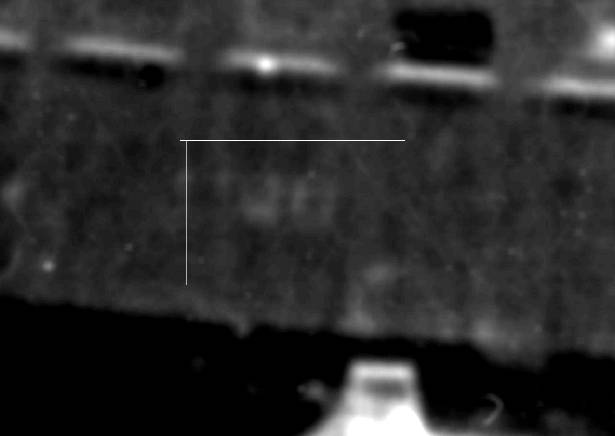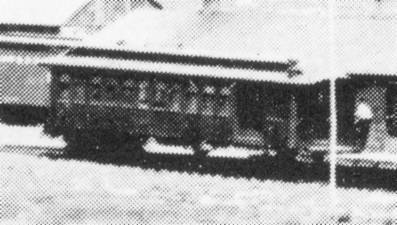Coach-Baggage #26
|
DSP&P |
U.P. 1885 |
DL&G 1889 |
C&S 1899 |
C&S 1906 |
| #26 |
#705 |
#705 |
#127 |
#26 |
 |
 |
|
(1)
We originally identified this car as coach #10, which was early on converted
to a coach-baggage car. But the above extreme close-up of the number,
located below the 6th window from the back (right) of the car certainly
appears to be a 20-something, likely either 0, 6 or 8. Remember in looking
at the
close-up that the number
slants downward to the left at the same angle as the upper photo. (The dots are from the paper on
which the picture is printed.)
(2)
Below is a
photo of the other side of the same car, and below it are two extreme
close-ups of the number below the 6th window from the back (left) of the
car. Again remember the number slants downward, this time to the right, at
the same angle as the car in the full-size photo. What do you think? Is it
a 20, 26 or a 28? (Hint: Both DSP&P car #20 and car #28 were coaches throughout
their lifetime. |
 |
 |
|
Photo #1 was taken by W.H. Jackson
sometime in the 1880s. It can be
found at
Chappell-55(u),
Ferrell/SoPk-277(d),
Kindig-300,
Speas-60 and online (Image
CHS.J908, X-8327 or WHJ-823 in the Denver Public Library’s
Western History Collection).
Photo #2 was taken by W.H. Jackson in the 1880s at
London Junction. It can be found at
Chappell-55(d),
Digerness2-265,
Ferrell/SoPk-277(u),
Poor-272(u)(ME),
Speas-61, and online (Image
MCC-3235 or CHS.J910 in the Denver Public Library's Western History
Collection) and online at The Narrow Gauge Circle, Ted Kierscey Collection
Image 00446. |
DESCRIPTION
Coach-baggage #26—if indeed the car in the photographs above is
#26—was originally a 40'-0" long car with 11 square,
double-pane windows,
two or more of which were probably in the baggage compartment. It looked rather
like a 14 window coach with a baggage door replacing the 2nd and 3rd windows
from one end. It appears that, like DSP&P coach-baggage #6, the single window
between the baggage door and the end of the car was replaced
with a solid panel.
The baggage door extended up through the narrow
letterboard to the eave line.
The car had end platforms
at both ends, and the
platform roofs had the
duckbill profile of a bygone era
(and appears to be the only South Park car to have had it). Each
window had a separate sill; there was no hint of a
beltrail. The stove in the
baggage end was in the opposite corner from the one in the passenger end. There
was something that looked like a battery box just ahead of the rear truck.
 |
|
(3) Is this the same car? Can’t be sure of
the roof contours, but the windows, door, clerestory,
narrow letterboard and flat eaves sure match! J.B. Sturtevant photo at
Ferrell/SoPk-229(u). |
HISTORY
According to
our best information, coach-baggage car #26 was built in 1879 by the
Ohio Falls
Car Company of Jeffersonville, Indiana. It appears to have been received by the South Park and
entered on its roster in middle to late 1880. There are two possible
explanations for this:
| 1. |
|
the Ohio Falls Car Company was one of the few—if not the only—car builder that offered off-the-shelf cars. All others built cars only to
order. This might explain why coach-baggage #26 had the duckbill roof that was
long out of style. |
| 2. |
|
some authorities think this car was built for the ATSF
and acquired
by the South Park along with the
Bowers-Dure coaches.
We don’t know at this point what evidence there is for this, so we are in no
position to evaluate the assertion. |
Some authorities also believe that
car #26 was a coach when acquired and rebuilt
as a combination car before the 1885 renumbering, at which time it was given a
coach-baggage number. Again we don’t know at this point what evidence there
is for this, so we are in no position to evaluate the argument. But an early
rebuild would explain why the early photos show a car that looks like a coach-with-a-baggage-door
(similar to #1 and #6). It may even be that the Ohio Falls company itself had an
old coach on hand and inserted a baggage door to fill the South Park’s order for
a combination car.
In any event, at the time of the 1885 Union Pacific renumbering, car #26 was a
coach-baggage car, and was renumbered #705, a number it kept under the Denver
Leadville and Gunnison. When received by the C&S in 1899, it was renumbered
#127.
According to the
passenger car
diagram for C&S
coach-baggage #26, it was
rebuilt in 1893 by the UP. This must have been one heck of a rebuild, for
a 1902 photo of C&S #127 shows a substantially different car.





